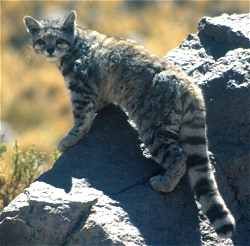Ghosts of the mountain- the Andean cats

High in the Andean mountains of South America live some of the rarest small wild cats known to man. So rare are these cats that until 1998 almost the only evidence that they existed at all were two photographs. After 1998 Jim Sanderson, founder and director of the Small Wild Cat Conservation Foundation became interested in these elusive animals. The little we now know of the creature today called the Andean cat is largely due to Jim Sanderson's determination and individual effort.
Andean cats are the rarest of the two dozen or so small wild cats. It is estimated that there are less than 2500 cats in the entire species. It is hard to estimate exact numbers because these cats live in the most inhospitable parts of the Andes mountains, well above the tree line and between three and five kilometers above sea level. To date the cats, or evidence for them, have been found in the high mountains of Peru, Bolivia, Chile and Argentina.
Studies of the Andean cat are not helped by the fact that none have been kept in zoos, and in the wild this small creature is wary of humans - with good reason. Unfortunately the Andean cat, like the Pampas cat, has the unfortunate privilege of being considered a sacred species by some Andean cultures. These cats are associated with abundance and welfare, and their skins are used in ceremonies where people mark their llamas and alpacas. The skins are also used at the beginning of the sowing and harvest periods, and demand for cat skins puts an already rare animal further at risk.
Andean Cats weigh about the same as the average domestic cat, tipping the scales at about 5.5kg (12lb). They appear larger than they are because they sport tails almost half a meter in length. Unsurprisingly given their habitat, these cats also have very thick fur which adds to their apparent bulk. Like the snow leopards with which they share the mountain peaks, Andean mountain cats have silvery-grey fur which camouflages them almost perfectly against the rocks. The body outline is further broken up by black or brown rings around the tail and legs, and the underside is white with numerous black or brown spots.
The main prey of the Andean cat is a rabbit-like rodent called the viscacha which is found across most of the high Andes. Like any felines, Andean cats probably don't say no to the occasional mouse or bird if the opportunity to add these to the menu arises.
The few times an Andean cat has been sighted have been in the daytime. However this is probably less because the cats are diurnal than because the few humans who end up in the high Andes at night must put urgent issues such as survival above leisure activities such as cat-spotting. The Andean cat is probably nocturnal, like most cats. According to local people, the cats' mating season is (probably) between July and December and litters are born between October and April. (This being the southern hemisphere, October and March/April are spring and summer respectively.)
The Andean Mountain Cat is of the felidae family, the species being Leopardus Jacobita. Until recently it was believed that Andean cats had barely enough numbers to make up a species, let alone have a subspecies. However, the Wildlife Conservation Society and its partners have just published a new study (see the reference below) which suggests that a slightly different breed of Andean cats may be found on the Patagonian steppe at a much lower elevation of about 600 m.
According to genetic studies carried out by Daniel Cossios (a co-author of the new study), this new sub-species appears to represent an evolutionary lineage distinct from the highland population. This data comes from samples which the team collected at different locations between 2007 and 2009. These samples included scat, skulls and skins which DNA analysis confirmed as being from an Andean cat species.
The discovery of a new sub-population of Andean cats is an important finding. Over time having another species of Andean cat to study will increase our knowledge of these rare cats. The challenge now is to make viable conservation plans for the newly-discovered Pantagonian subspecies, and to learn more about their elusive cousins on the high mountain peaks.
Journal Reference:
- Andres Novaro, Susan Walker, Rocio Palacios, Sebastian Di Martino, Martin Monteverde, Sebastian Canadell, Lorena Rivas, and Daniel Cossios. Endangered Andean cat distribution beyond the Andes in Patagonia. CATnews, 53 (Autumn 2010).

